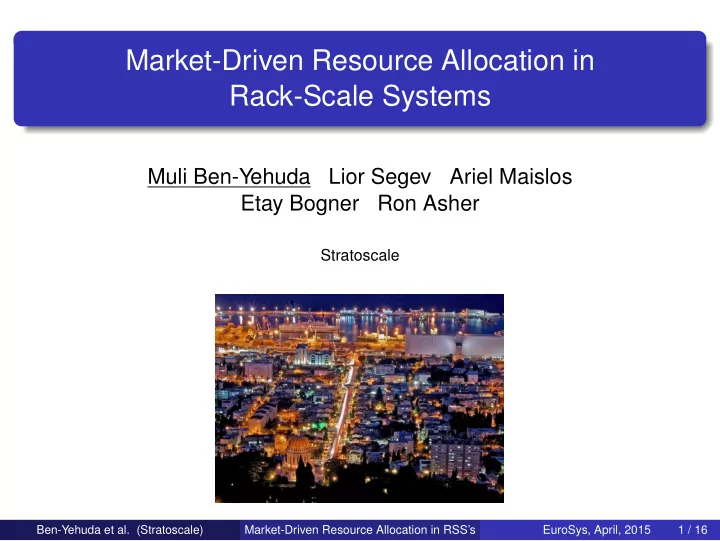

Market-Driven Resource Allocation in Rack-Scale Systems Muli Ben-Yehuda Lior Segev Ariel Maislos Etay Bogner Ron Asher Stratoscale Ben-Yehuda et al. (Stratoscale) Market-Driven Resource Allocation in RSS’s EuroSys, April, 2015 1 / 16
The Stratoscale Rack-Scale Hyper-Converged System Hyper-converged x86 system: compute + storage + networking Scales from 4–1000 nodes Resources: CPU cycles, memory, network and storage bandwidth Cloud-like: many rational and selfish users Distributed storage and distributed memory Fast live migration of workloads between nodes Ben-Yehuda et al. (Stratoscale) Market-Driven Resource Allocation in RSS’s EuroSys, April, 2015 2 / 16
The Problem How do you allocate resources efficiently? Ben-Yehuda et al. (Stratoscale) Market-Driven Resource Allocation in RSS’s EuroSys, April, 2015 3 / 16
Efficient Resource Allocation Give the right resource to the right workload at the right time Ben-Yehuda et al. (Stratoscale) Market-Driven Resource Allocation in RSS’s EuroSys, April, 2015 4 / 16
Difficulty Increases As Load Rises Ben-Yehuda et al. (Stratoscale) Market-Driven Resource Allocation in RSS’s EuroSys, April, 2015 5 / 16
Metrics System utilization Fairness Responsiveness Useful work Ben-Yehuda et al. (Stratoscale) Market-Driven Resource Allocation in RSS’s EuroSys, April, 2015 6 / 16
Ben-Yehuda et al. (Stratoscale) Market-Driven Resource Allocation in RSS’s EuroSys, April, 2015 7 / 16
Potential Solutions Fixed static allocation 1 + Simplest possible approach - Workloads come and go, demands change Let the users decide 2 + Users know best - Rational users will game the system to get more Monitor behavior and give suffering workloads more resources 3 + Fair - Breaks when load increases: someone will have to suffer - Reactive not proactive: alleviates suffering but does not prevent it - Rational users can still game the system So what should we do? Ben-Yehuda et al. (Stratoscale) Market-Driven Resource Allocation in RSS’s EuroSys, April, 2015 8 / 16
Let The Market Work It Out Ben-Yehuda et al. (Stratoscale) Market-Driven Resource Allocation in RSS’s EuroSys, April, 2015 9 / 16
RackCoins: The Virtual Rack Currency Workloads use RackCoins to pay for resources Ben-Yehuda et al. (Stratoscale) Market-Driven Resource Allocation in RSS’s EuroSys, April, 2015 10 / 16
RackCoins: Where Do They Come From? Each workload has a RackCoins budget A workload may buy RackCoins using real currency (e.g., e ) A workload may be granted RackCoins by the system’s admin When the budget runs out, the workload or the admin need to replenish it or the workload will stop running Ben-Yehuda et al. (Stratoscale) Market-Driven Resource Allocation in RSS’s EuroSys, April, 2015 11 / 16
RackCoins: How Do You Spend Them? Workloads are guaranteed some minimal amount of resources Workloads bid for additional resources If they win, they use them If they lose, they can bid again next round presumably with a higher bid The system collects bids, calculates the going market rate for each resource, decides who won, and allocates resources to the winning workloads The system migrates workloads between nodes to maintain a rough price equilibrium between nodes Goal: maximize satisfaction, not (necessarily) profit Ben-Yehuda et al. (Stratoscale) Market-Driven Resource Allocation in RSS’s EuroSys, April, 2015 12 / 16
Does Bidding Make Sense? static hinted-host-swapping Upper Bound ginseng hinted-mom Ginseng Simulation 3.5 3.0 Social Welfare [$/s] 2.5 2.0 1.5 1.0 0.5 0.0 6 7 8 9 10 11 12 13 Number of VMs Ginseng [VEE’14] shows a 6.2x–15.8x improvement in social welfare (83%–100% of the optimum) when workloads bid for memory Ben-Yehuda et al. (Stratoscale) Market-Driven Resource Allocation in RSS’s EuroSys, April, 2015 13 / 16
Why Does It Make Sense? A properly designed bidding mechanism induces rational clients to tell the truth about their needs Truth telling enables the system to give the right resource to the right workload at the right time Utilization is maximized because no resource is wasted Fairness is maximized because the workload that needs a resource most gets it Useful work is maximized because the workload that does the most important work (i.e., needs a resource the most) gets it The users’ satisfaction is maximized due to all of the above Ben-Yehuda et al. (Stratoscale) Market-Driven Resource Allocation in RSS’s EuroSys, April, 2015 14 / 16
A Bidding Workload’s Woes Bidding requires workload awareness: How much are resources worth to me and how much should I bid? Bidding requires workload elasticity: How do I make do with less or more resources? Bidding requires profit-maximizing workloads: How do I maximize my profit given the resources I have been allocated? Ben-Yehuda et al. (Stratoscale) Market-Driven Resource Allocation in RSS’s EuroSys, April, 2015 15 / 16
Conclusions Rack-scale systems should allocate resources according to supply and demand by having workloads bid for them This is the only approach we are aware of that (1) cannot be gamed; and (2) maximizes users’ satisfaction We are experimenting with market-driven resource allocation in the Stratoscale system Ben-Yehuda et al. (Stratoscale) Market-Driven Resource Allocation in RSS’s EuroSys, April, 2015 16 / 16
Recommend
More recommend